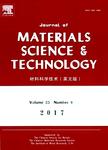Comparative Study of the Structure and Properties of Ti—O-based Nanowire Films Prepared by Anodization and Chemical Oxidation Methods
Comparative Study of the Structure and Properties of Ti—O-based Nanowire Films Prepared by Anodization and Chemical Oxidation Methods作者机构:Resource & Environment Catalysis Institute College of Chemical Engineering and Materials ScienceZhejiang University of Technology College of Biological and Environmental Engineering Zhejiang University of Technology
出 版 物:《Journal of Materials Science & Technology》 (材料科学技术(英文版))
年 卷 期:2014年第30卷第9期
页 面:878-883页
核心收录:
学科分类:07[理学] 070205[理学-凝聚态物理] 08[工学] 080501[工学-材料物理与化学] 0805[工学-材料科学与工程(可授工学、理学学位)] 0702[理学-物理学]
基 金:supported by the Natural Science Foundation of Zhejiang Province China(No.LY12B07011)
主 题:Anodization Nanowires Thin films Titanium dioxide Titanate
摘 要:Net-like titanium oxide or H-titanate nanowire films were grown on Ti substrates in 2 mol/L NaOH solutions at 80 ℃ via anodization method or chemical oxidation followed by proton-exchange. The microstructure, thermal stability and photoelectrochemical property of two types of films were investigated by scanning electron microscopy, transmission electron microscopy, X-ray diffraction, and photocurrent measurement. It is found that the anodic film mainly consists of a 500-nm-thick nenowire layer whereas the film formed by chemical oxidization is made up of two layers: a nanowire layer (nearly 1 tim in thickness) and an underlying non- nanowire layer (at least 1 μm in thickness). In both two cases, the as-formed nanowires are partly crystallized. Thermal stability investigation reveals that the net-like structure of the anodic nanowire film almost keeps unchanged at a temperature less than 400℃ but is totally destroyed when being calcinated at 600 ℃. In contrast, the nanowire layer formed by chemical method is stable even after being calcinated at 600 ℃. Our results also show that the uncalcinated or calcinated anodic films are much more photoactive than the corresponding films prepared by chemical oxidization. The difference in photoelectrochemical property of two types of films is discussed based on their microstructures.



